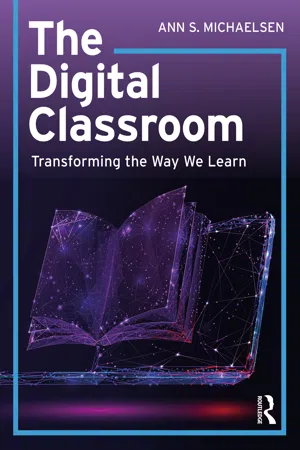
The Digital Classroom
Transforming the Way We Learn
Ann S. Michaelsen
- 128 pages
- English
- ePUB (mobile friendly)
- Available on iOS & Android
The Digital Classroom
Transforming the Way We Learn
Ann S. Michaelsen
About This Book
The way students learn changes when they have access to digital tools. The Digital Classroom demonstrates that using technology to enhance students' learning is not dependent on a specific learning management system or software – it is about changing the pedagogy with the help of an arsenal of useful tools and methods.
This practical book introduces easy to use methods to all teachers in digital classrooms with the intention to make it simple, accessible, and achievable for everyone. It is not only about the tools, and the how and why, but also about changing the pedagogy making the learning more relevant to the students. When you open the classroom to the rest of the world, the teacher becomes more important than ever. Topics in the book include:
-
- Technology and deeper learning
-
- Social media in the global classroom
-
- Building a personal learning network
-
- The flipped classroom and cooperative learning
-
- The use of iPads in primary and middle school
-
- Teaching with videogames
-
- Special education
-
- Digital citizenship
Digital tools can play a key role in making learning happen and what the teachers know about the use of technology is key. The Digital Classroom will be of great interest to teachers and trainee teachers who wish to develop their digital competency by using the book as part of their professional learning.
Frequently asked questions
Information
chapter
1
Learning in the digital classroom
Introduction
Technology in school
A pedagogy for deeper learning
Deeper learning is a critical and higher-order thinking model that is made up of the following six competencies: master core academic content, think critically and solve complex problems, communicate effectively, work collaboratively, learn how to...
Table of contents
- Cover
- Half Title
- Endorsement Page
- Title Page
- Copyright Page
- Table of Contents
- Acknowledgments
- List of Contributors
- Introduction: A significant change in teaching and learning
- Chapter 1: Learning in the digital classroom
- Chapter 2: Digital tools for the classroom
- Chapter 3: Social media in the global classroom
- Chapter 4: Tablet PCs in primary and middle school
- Chapter 5: Cooperative learning
- Chapter 6: The flipped classroom
- Chapter 7: Teaching with video games
- Chapter 8: Digital citizenship
- Chapter 9: Special needs education
- Chapter 10: The digital classroom: What is the insight from contemporary educational research?
- Index